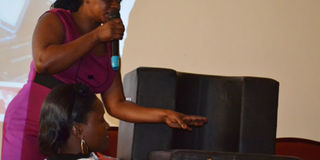Innovations that are helping to improve maternal health

The Sayana press contraceptive device. Injectable contraceptives are a widely used method of family planning in Uganda. File photo
What you need to know:
Maternal mortality remains a big challenge in Uganda. But as we outline below, several innovations are being used to address the problem.
Sometimes it is not the big discoveries that we need. Depending on the circumstances, small innovations can make the difference we need.
In Uganda, where 16 women die every day from complications related to childbirth, according to a report by Save the Children, simple initiatives such as access to a waiting room at a health facility can be that difference.
For instance, the hilly terrain of Kanungu District, in south-western Uganda, coupled with the poor roads and lack of transport has had a huge bearing on the health of mothers and children.
“Mothers from hard-to-reach areas find it difficult to deliver from a health facility because of the complications involved in accessing such facilities,” says Rosemary Aturinda, a nurse at Kanungu Health Centre IV.
Now with a waiting room, mothers from hard-to-reach areas can come to the facility a few days before their due date, where they will stay until they give birth.
However, even after giving birth, the mothers can stay on for more days until they are ready and fit enough to make the journey back home.
Impact
Although the idea of a waiting room was initially received with scepticism by the expectant mothers, many are now embracing it and ensuring they reach the facility before they give birth.
The success of this initiative is already being reflected in the number of women coming to deliver at the health facility, which has grown from 17 to 50 per month.
Birth cushions and solar suitcases
Under the project “responding to chronic emergencies in Karamoja”, Doctors with Africa, a non-governmental organisation operating in the region is popularising the use of birth cushions for mothers during labour.
According to Christine Oseku, the midwife supervisor with Doctors with Africa, many expectant mothers are not comfortable lying down while giving birth, and instead, prefer to squat.
The birth cushions are an improvement to the traditional squatting method. They are made in a chair-like structure, with a curved opening at the front, which makes it easy for a woman in labour to push while seated in a relaxed posture.
The baby is received on the cushion’s extension, which has a pillow-like form. The cushion set also has a stool on which the midwife sits as she aids the delivery. Birth cushions are supplemented with the use of solar suitcases.
In rural areas where electricity supply is limited, the solar suitcase provides lighting in the maternity wards, so that midwives are able to carry out deliveries regardless of the time of the night.
Male action groups (MAGs)
The male action groups (MAGs) is another initiative through which men are being involved in reproductive health programmes.
The importance of male participation in reproductive health can be illustrated by the uptake of these services in Kotido District.
Here, men are given education on how to treat their wives while they are pregnant, and how to assist them when the labour pains start at home. The men are also sensitised on the use of family planning services and other health topics such as HIV/Aids.
As a result of MAGs, couples are able to agree on the family planning method that is suitable for them and also know their HIV status.
In Mororto District, the MAGs have also increased the number of couples counselled and tested together at various health facilities from 667 in 2012, to 7,452 in 2014.
Those who tested and went to receive their results together also grew from 507 in 2012, to 7,134 in 2014. In a community where childbirth is still considered a woman’s responsibility, more sensitisation is needed to ensure men take part in accompanying their spouses to the health facility.
Village ambulances
Like it is the case in Kanungu, many mothers in Yumbe District have a big challenge accessing health centres for regular antenatal services. Mary Aleni, the officer in charge of maternal and child health in Yumbe District, says the presence of village ambulances has made referrals from the communities to the health facilities, easy.
Aleni says it is the community that raises money to fuel and maintain the ambulances. While such initiatives are improving maternal health, Alenu says the challenge has been the limited money collected from the community to run the ambulance services.
The WinSenga innovation
The innovation called the WinSenga, is a software application used on a windows phone that enhances and extends the functionality of a pinard horn to deliver timely, effective, quality and affordable antenatal diagnosis and care.
It uses a smartphone based ultra sound alternative that feeds into a community based diagnosis and referral system.
The phone has a global positioning system (GPS) and a microphone to connect the two devices. During diagnosis, the pinard foetal stethoscope is put on the expectant mother’s womb, which then transmits the sound to the smartphone.
The health worker then sends the summary to the expectant woman on the phone.
Joshua Okello, one of the developers of the application says it has the potential to reduce maternal mortality figures, especially in rural areas where there is limited access to vital services.
While this is a promising innovation, the main limitation is the limited use of smartphones by health workers in rural areas.




